
|

|
|
Home Site Search Contact Us Subscribe
|
|
|
Beyond the Egg-crate Museum: Reflections on the Bloch Building Q&A with Nelson-Atkins Museum of Art Director/CEO Marc Wilson re: life at Steven Holl Architects' Bloch Building - three years after opening. By Norman Weinstein January 19, 2010 As a new museum evolves and seasons, it becomes a less sensational object of media attention. And more significantly, there is no universally accepted, clear measure, no sensitively accurate form of post-occupancy evaluation to track a museum’s utility and beauty after the last hurrahs of its grand opening fade.
A perfect example of a museum that deserves to remain in the public eye is the Nelson-Atkins Museum of Art in Kansas City, with its sensational Bloch Building extension designed by Steven Holl Architects. Debuting in 2007, it houses the museum’s African Art, Photography, and Contemporary Art collections. I interviewed Marc Wilson, Director/CEO of the Nelson-Atkins, by phone, to discover his sense of how the Bloch Building’s architecture works for him and the general public, nearly three years after its opening. So vividly did the experience of the Bloch Building come through our interview, that I hope you’ll indulge me in imagining that Marc and I had this interaction at the museum site. Marc Wilson’s responses are verbatim; mine mix actuality and fantasy over time, much in the fashion of the Bloch Building itself.
Norman Weinstein: This is my first experience moving through the Bloch Building, and I’m feeling transported from gritty Kansas City to some version of a museum that would fit in the Emerald City of Oz. There’s an overwhelming feeling of lightness and transparency, as if I’m daydreaming this building as we talk. It feels like the architecture has induced a meditative state – or am I attributing to Holl’s architecture my own spacey awareness at this second?
Marc Wilson: We set out to provide the public with a museum that gently leads them into a state of mind where they engage in a keen dialogue with the art itself. And we don’t foreground the building in any way that would distract from direct viewer engagement with art.
NW: But driving toward the museum site, it’s impossible not to be aware of Holl’s five starkly austere, contemporary glass towers juxtaposed with your original neo-classical building. Yet as we saunter through the Bloch extension, and I catch glimpses of your original building, it appears removed from my viewing of, say, your Rothko in this new space. I’ve seen Rothkos in numerous museums here and in Europe – yet in this building I feel a greater intimacy with Rothko’s color field, its luminosity floating off his canvas and mixing with the natural light in this gallery.
MW: We want the visitor to feel that he or she has entered into a special world found nowhere else, different from the everyday world. This building is designed to sharpen the powers of a visitor’s imagination, intelligence, and emotion.
NW: It’s having that impact on me, something akin to being able to navigate the interior of a Joseph Cornell box where surprise is a constant.
MW: The building offers an open-ended, constantly refreshing experience, moment by moment. It’s a space where visitors enter an Alice-in-Wonderland type environment where they don’t know what to expect moving from one space to the next.
NW: But Alice was perturbed as well as delighted by the spatial surprises of Wonderland. How has the general public accepted this building since its opening?
MW: The public response has been overwhelmingly favorable since the opening. Remember that we invited public input during the three year planning process. Even those who might not like the Bloch Building in daylight, wishing the exterior had decoration, while overlooking the detailing, love it at night when it is universally appreciated as an enchanted fairyland. It has been overwhelmingly, immediately accepted – in contrast to the [Claes Oldenburg/Coosje van Bruggen] shuttlecocks on our lawn.
NW: How has moving between the Bloch Building (where you have your office) and the original building that houses the museum’s extraordinary Chinese collection impacted your perception of the Chinese art?
MW: I can imagine how the Chinese art in the original building would appear if transported into the new. This offers fresh perspectives on the art; this contrast between the buildings I constantly experience.
NW: And as we approach the old building, the question arises: do you see the two buildings as well integrated now as in 2007?
MW: Very much so. Central to the Nelson-Atkins Museum of Art from its start in 1933 has been to concentrate as much as possible on making art accessible to a wide audience, even within the limitations presented by the original building. If I’ve done my work, the space the art is designed for disappears, and the art itself becomes the visitor’s primary experience.
NW: Back to the subject of the original building&hellip
MW: The original building design represents everything I wanted to break away from by creating this extension. I had long desired to break out of that 200-year-old notion of the art museum as orthogonal egg-crate. Even before the Bloch Building, we had tried to present visitors with stimulating shifts among different kinds of environments to enrich their interactions with art. The timing was serendipitous when we met Steven Holl because we had spent three years in groups clarifying and planning the kind of fluid design we wanted. We didn’t need the architect to tell us who we were. The Bloch Building represents the materialization of a long-held belief that the traditional egg-crate museum would no longer work. The grip of that convention supported by much of the art museum industry had to be broken. The Bloch Building was the opportunity to break that grip.
NW: I was watching shafts of sunlight dance above us on the ceiling.
MW: The Bloch building presents light as like putty. River-like. Elastic. Ever-changing.
NW: Reminds me of the advice Hemingway gave fellow writer John Dos Passos: “Don’t forget to put the goddamn weather in your novel.” Turbulent radiant weather seems to constantly flow through your building
MW: I don’t like homogenized light. Or buy into the idea that natural light is of a different order than sunlight. Light is light.
NW: And Steven Holl understood your vision of light in a museum when he designed these five linked glass towers as “lenses.” I’m struck by the fact that Holl hardly needed to persuade you of the cogency of his design.
MW: We were of the same mind. No persuasion on his part was needed.
NW: Ending on a personal note: when you retire from your position as museum director this summer, have you anticipated how you might miss working in this building?
MW: I simply look forward to exploring what’s around the next bend in the river.
Norman Weinstein writes about architecture and design for Architectural Record and The Christian Science Monitor, and is the author of the monthly “Words That Build” – an exclusive series on ArchNewsNow.com focusing on the overlooked foundations of architecture: oral and written communication. He consults with architects and engineers interested in communicating more profitably. You can reach him at nweinste@mindspring.com.
Also by this author:
Op-Ed: Life After Ada: Reassessing the Utility of
Architectural Criticism
Book Review: How to
Make Versions of the Past Present: "Robert A.M. Stern Buildings and
Projects 2004-2009"; Peter Morris Dixon, editor
Best
Architecture Books of 2009
Book Review: "Gunnar Birkerts: Metaphoric Modernist" by Sven Birkerts and Martin Schwartz A major architect in the history of Modernism finally receives recognition – and sundry asides about why Modernism never exited.
Book Review:
"Urban Design for an Urban Century: Placemaking for People," by Lance
Jay Brown, David Dixon, and Oliver Gillham
Book Review:
"Everything Must Move: 15 Years at Rice School of Architecture
1994-2009"
Book Review: A Subversive Book Every Architect Needs:
"Architect's Essentials of Negotiation" by Ava J. Abramowitz
Book Review: A Perspective from One Elevation: "Conversations With Frank Gehry" by Barbara Isenberg Gehry's conversations offer portraits of an astute listener as well as talker, an architect as aware of his flaws and limitations as of his virtues.
Best Architecture Books of 2008
Book Review: You've Got to Draw the Line Somewhere A review of Drafting Culture: a Social History of Architectural Graphic Standards by George Barnett Johnston
Book Review: "NeoHooDoo: Art for a Forgotten Faith," edited by Franklin Sirmans Sharpen your pencils - and get ready to do a NeoHooDoo shimmy.
|
(click on pictures to enlarge) 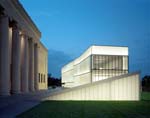 Courtesy The Nelson-Atkins Museum of Art The Nelson-Atkins Museum of Art and Bloch Building 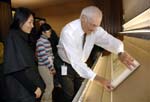 Courtesy The Nelson-Atkins Museum of Art Marc Wilson installing a Chinese painting exhibition in which he worked with graduate art history students at the University of Kansas to create 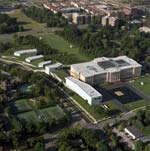 Courtesy The Nelson-Atkins Museum of Art Aerial view 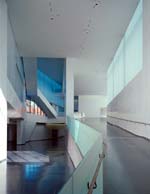 Roland Halbe, courtesy The Nelson-Atkins Museum of Art Bloch Building interior 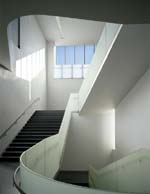 Roland Halbe, courtesy The Nelson-Atkins Museum of Art Bloch Building interior 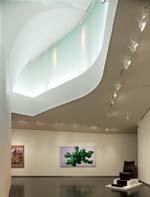 Roland Halbe, courtesy The Nelson-Atkins Museum of Art Bloch Building gallery 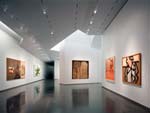 Roland Halbe, courtesy The Nelson-Atkins Museum of Art Bloch Building gallery 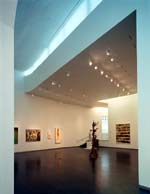 Roland Halbe, courtesy The Nelson-Atkins Museum of Art Bloch Building gallery 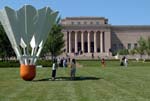 Courtesy The Nelson-Atkins Museum of Art One of four “Shuttlecocks” (1994), by Claes Oldenburg and Coosje van Bruggen 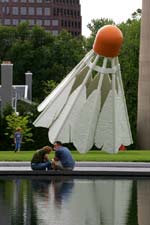 Courtesy The Nelson-Atkins Museum of Art Second of four “Shuttlecocks” (1994), by Claes Oldenburg and Coosje van Bruggen 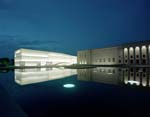 Courtesy The Nelson-Atkins Museum of Art Bloch Building at night |
© 2010 ArchNewsNow.com